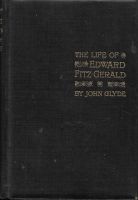The Tomb of Omar Khayyám. Sarton, George. ISIS, 29 (1938) 1 (July) pp. 15-19.
Archives
A chronological list of the more important issues …
A chronological list of the more important issues of Edward FitzGerald’s version of the Rubaiyat of Omar Khayyam, and of other books, written, translated, edited or owned by him with portraits, autograph letters, etc. ; and with ana, other versions of the Rubaiyat, and certain items identified with his name, or forming part of his Persian studies ; exhibited by the Caxton club, January fourth to January twenty-first, 1899. Chicago, Caxton Club, 1899.
A concordance to FitzGerald’s translation of the Rubáiyát of Omar Khayyám
A concordance to FitzGerald’s translation of the Rubáiyát of Omar Khayyám. J.R. Tutin. London, Macmillan and Co.; The Macmillan Company, 1900
The life of Edward FitzGerald
The life of Edward FitzGerald. With an introduction by Edward Clodd. John Glyde. London, Pearson, 1900. 358 pp.
Omar and his translator
Omar and his translator. W.F. Prideaux. Ely, Printed by E.H. Blakeney at his private press, Ely, Cambs., 1909. 16 p.
Sufism. Omar Khayyam and E. FitzGerald
Sufism. Omar Khayyam and E. FitzGerald. Bjerregaard, C.H.A. London, The Sufi Publishing Society, 1915. 48 p.
Contents:
Preface
Sufism: an appreciation
Interpretations, Sufism as a doctrine of life
Umar Khayyam and his age
Umar Khayyam and his age. Otto Rothfeld. Bombay, Taraporevala, 1922.
Summary:
Study of Omar Khayyám’s life and works, in correlation to the historical and spiritual development of Islam. With quatrains from Whinfield’s translation.
Contents:
Umar’s Life and Period
The Significance of Umar’s Ruba’iat



